If you're a coach, consultant, and/or service-based business – this post is for you!
Likewise, speakers, authors, teachers, and entrepreneurs in the business of selling themselves can also glean insights from this post!
Finally, if you sell digital or info products and professional services – this post will show you how to make the most of what you offer!
It's the most comprehensive marketing strategy post you'll find on the Internet, I guarantee it.
Whether you're trying to develop your marketing strategy or you feel like you've got things figured out, I recommend giving this post a gander. I'm sure I'll shed some light on areas you haven't even considered.
To help assist you, I've put together a fill-in-the-blank document that can be downloaded by clicking the link below:
Let's get started.
The Master Plan
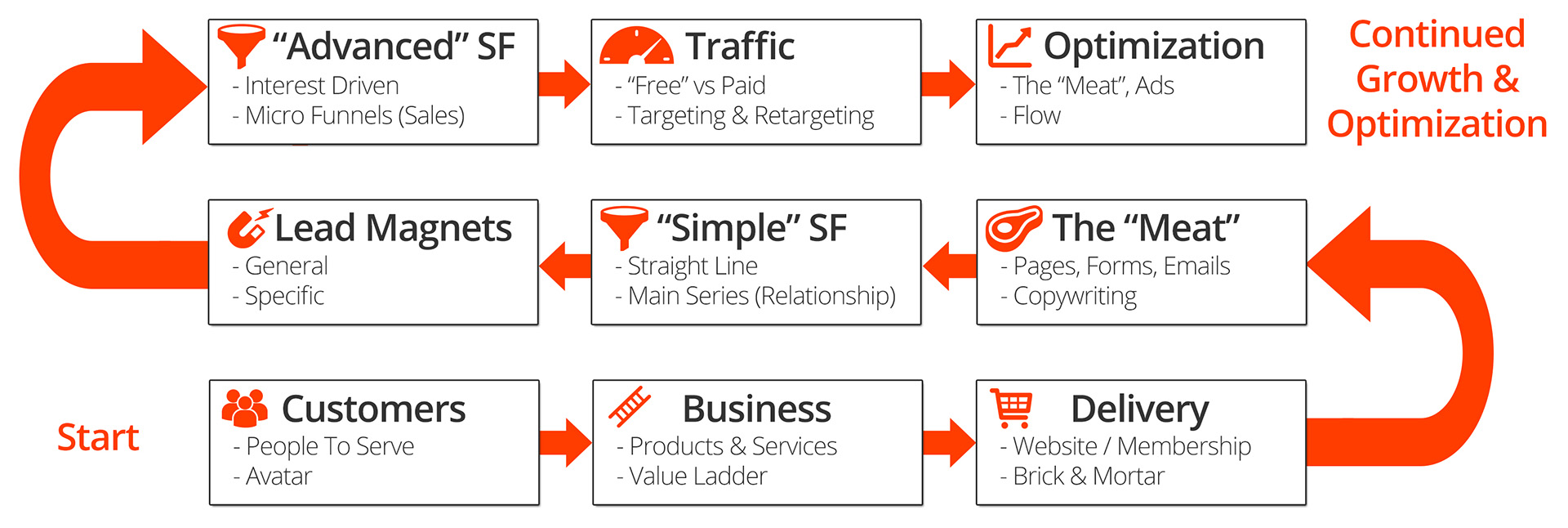
This is the master blueprint we'll be following to build your marketing strategy.
I urge you not to skip ahead to the “cool” stuff that involves automation, tracking, and other nifty tools. Yes, that stuff is fun; however, if you don’t build a solid foundation, you’ll wind up spinning in circles and produce minimal results.
So, please, take the 60 minutes to define your customer and your business before moving forward!
Scenarios
I'll be using a couple model businesses in order to provide examples:
- Business #1 – Offers digital products, coaching, consulting, and services – ie. Crazy Eye Marketing
- Business #2 – Offers digital products and services – ie. a financial advisor
- Business #3 – Only offers services – ie. a dentist
As we get into the “Business” section, I'll discuss the particular offerings of each model business.
Customers
If you've read anything on marketing strategy in the past, you've likely come across articles about your customer and the importance of “defining” your customer.
This makes sense. If you're not sure who your business is for … then, what are you doing?
More than likely, you already know who your ideal customer is; however, you probably haven't truly defined them.
I understand, it can take a lot of time to develop a full fledged customer avatar or marketing persona … and, quite frankly, it sounds kinda boring, especially when there are a bunch of tools and fancy automations to get to!
But, here's the deal – having a more defined ideal customer does two things:
- Helps you find them
- Helps you connect with them
Two really important factors that help alleviate potentially HUGE problems!
If you can't find your ideal customer, you won't be able to attract them.
If you can't connect with your ideal customer, you won't be able to do business with them. People they know, like, and trust. If you can't get people to know, like, and trust you – your business will struggle.
To save you the time of going and filling out a customer avatar worksheet, simply answer these 5 questions:
- What’s your ideal customer’s name? You need to give them a name!
- Dave
- Marshall
- Jenna
- Where do they hangout? / How can you get in front of them? Online, offline, particular websites, forums, Facebook groups, etc.
- Facebook groups, forums, marketing/small business websites
- Newspaper, home, travel websites
- 15 mile radius, schools, libraries, grocery stores
- Where are they in the journey of life? Baseline demographics, thoughts, desires, fears, etc.
- 30ish years old, young family, starting a small service-based business, trying to make things work, wants to support their family.
- Retirement age, ready to stop working, wants to travel the world, wants to maximize time with family and friends.
- Stay at home mom with young children, wants to take care of her kid's health.
- How do they see themselves? / How do they present themselves?
- I'm relatively smart and hardworking – more so than the average Joe. Can do anything I put my mind to, sky's the limit!
- I've done my time, I'm now a world renowned adventurer ready to conquer anything!
- A good mother, first and foremost. I'm the caretaker of my family.
- How well do they know your products and industry? Do they “live” it, are they “new” to this world, etc.?
- Semi-new to the business of digital marketing (~ 6 months). Has some basic concepts down, but hasn't quite pieced it all together yet.
- Understands the very basics of wealth management. Put money into their 401k their whole life, has invested some on their own.
- They know about teeth cleaning and basic dentistry work as they've been going to the dentist their whole life.
See, it doesn't have to be too difficult! Your answers should simply be a stream of thought.
Just by going through this process you'll develop a new frame to look through as you produce your content and message.
Customer FAQ:
Q: I have more than one ideal customer, how should I handle this?
A: Yes, you likely do have more than one ideal customer which is great. Ask yourself the same questions for each customer. However, I have two recommendations:
1) Make sure they’re uniquely different. Make sure where they hangout is different, where they are in the journey of life is different, and how they see themselves is different.
2) Start with your top 1 or 2 ideal customers – 80% of your business. You can always add more “ideal customers” later on, and I recommend getting the low hanging, obvious fruit first.
To Do
Answer the questions above.
Business
There are three core aspects of your business to define before moving forward:
- Why you do what you do
- Who you/your business are/is
- How you help your customers (products and/or services) / What you do
If you're well-established, you can likely easily answer these questions; however, you probably haven't really “defined” them and mapped them out. I urge you to take the time to do this as it'll make the sales funnel development much simpler.
Why You Do What You Do
Why do you do what you do?
What's your mission?
Most people don't start a coaching, consulting, or service-based business accidentally.
What makes you leap out of bed in the morning? Is it to talk to clients? Help people? Make money? Is it creating or building?
What is it?
This doesn't have to be an official statement that you're going to put on your website. No one else is ever going to see it (unless you want them to).
It simply serves as a reminder when times get tough and helps you make decisions that align with your purpose.
It makes life easier.
Who You/Your Business Are/Is
There are other people and businesses that do what you do.
This is a good thing. If other people are having success doing what you're doing – that means you can too.
It also means you have competition and need to figure out a way to stand out.
The best way to stand out? Your personality or persona.
Being generic will not work in this day and age.
“Different is BETTER than better” – Sally Hogshead
Where Will This Persona Be Used?
This persona will be used in the content you produce, the correspondence you send, and across your entire business.
If your persona is fun and outgoing – everything about your business should be fun and outgoing.
This persona will be the “face” of your business.
How To Figure Out Your Business's Persona
If you're a solopreneur, this is an easy one – you are the persona.
Being a coach, consultant, service-based business, speaker, author, etc. – people need to know, like, and trust you.
Let your freak flag fly! You'll attract those that connect with you and repel those that don't.
If you're a business with multiple employees, there are a few ways to decide on your business's persona:
- Assume the personality of the owner/founder/CEO
- Develop a business persona that will connect with your ideal customer
- Have multiple personas. It's certainly acceptable to have multiple personalities, especially if you operate with a large team. The overall “feel” should be similar; however, each team could have their own persona for how they connect with customers.
Your Products And Services
The products and services you sell essentially translate to, “How you help people”.
Knowing what products and services come next in your customers' lifetime will help you deliver more value, which means increased revenue for your business.
Most of the time, coaches, consultants, and service-based businesses offer a wide array of products and services. This is great because you have a lot to choose from; however, so do your customers and if they don't have a clear path toward success – they'll get confused and choose nothing.
You need to take the time to map out your products and services to give your customers a clear path to success.
The Value Ladder (“The Map”)

The concept and implementation of a Value Ladder is what propelled my personal coaching, consulting, and service-based business from break-even to profitable.
It's simple, but powerful.
The idea is to offer products and services at varying levels of price and value while having each tier lead into the next one. Thus, over the lifetime of a customer, they're “ascending” your Value Ladder and you always have something to sell them.
The break down:
- Lead Magnets are usually freebies (coupons, videos, checklists, etc.) that attract and qualify leads
- Initial Offers are lower-end products/services that are ideally “too good to refuse” and get people in the door
- 1st Tier Offers are usually your core product or service and bring in about 80% of your sales
- 2nd Tier Offers are the “next” level up from the 1st tier
- Top Tier Offers are the best you have to offer, the full shebang!
Being that most coaches, consultants, and service-based businesses offer a wide array of products and services – the Value Ladder will be a bit more “advanced”:

Yup, Value Ladders inside of Value Ladders!
This will be explained through several examples.
Crazy Eye Marketing (digital products, coaching, consulting, services)
- Digital Products
- Lead Magnets: Checklists, videos, trials, discounts
- Initial Offers: “Cheaper” products and courses
- Top Tier: The Sales Funnel Training Vault
- Coaching (Group Setting, Recurring)
- Initial Offer: Monthly package
- 1st Tier: 6 month package
- Top Tier: Lifetime coaching package
- Consulting (Private)
- Initial Offer: 1 hour
- 1st Tier: 4 hours
- Top Tier: Custom
- Services (Done For You)
- Initial Offer: Small, simple, one-off jobs
- Top Tier: Custom
Financial Advisor (digital products, services)
- Digital Products (SaaS service similar to Mint and/or Wealthfront)
- Lead Magnets: Trial
- Initial Offer: Self managed
- Top Tier: Professionally managed
- Services
- Lead Magnet: 7 Questions To Ask Before Hiring A Financial Advisor
- Initial Offer: Free 15 minute Q&A
- Top Tier: Investment management, retirement planning, college planning, estate planning, debt reduction strategy
Dentist (services)
- Services
- Lead Magnet: Free teeth cleaning
- Initial Offer: Teeth whitening
- 1st Tier: Cavities, fillings, and other minor fixes
- Top Tier: Braces
- Recurring: 6 month appointments
As you can see in the examples above, some Value Ladders have several tiers while others only have a few.
The take away is you offer different products and services at different price points and value that ideally “ascend” individuals to the next thing you offer. However, there are instances where they may skip a tier or two in the process, for example with the dentist – a person doesn't need a cavity before they can get braces. Likewise, with Crazy Eye Marketing – someone doesn't need to hire me for coaching before I will do a custom job for them. That would be silly!
To Do
- Write down why you do what you do
- Write down Who you/your business are/is
- Map out your Value Ladder(s) – How you help your customers (products and/or services) / What you do
Delivery
The “Delivery” simply represents the way in which you deliver your products and services.
This obviously depends upon what you offer. For example, the dentist will need a place to see clients – he can't offer virtual root canals.
However, in this day and age, most coaching and consulting can be achieved over the Internet from the comfort of one's home.
So, it really depends – but you're an adult and I'm sure you know what you need in order to deliver what you offer.
Make Sure You Own It
I will say this – make sure you own your method of delivery.
For example, you wouldn't want to run your entire business off Facebook. What if Facebook decides you broke their terms of service and locks your account? What would you do then?
Another example, a lot of coaches run their business on Udemy. I'll agree, Udemy is convenient and brings in new customers; however, Udemy controls pricing and how you can engage with your customers. You can't email them whatever or whenever you want. You're at the mercy of the Udemy gods … which isn't a place you want to be.
A final example, many businesses are dependent upon Google and SEO to deliver their traffic. But, what happens if Google changes their algorithm and your business falls off the front page? Could you survive? Do you have a backup plan? If you own an email list, know how to grow it, and know how to sell to it – you won't need Google.
You need to have your own website, your own email list, your own setup. Something no one can take away from you.
Of course, use the other platforms and tools available in order to build your platform, but never be dependent upon them.
My Coaching, Consulting, and Services Setup
To give you an idea of how my business is setup, I've listed the key components below so you have some direction. If you'd like more details or specifics, please let me know.
- NameCheap: Domain registrar.
- a2Hosting: Managed VPS, Prestige+ package. Hosts my website.
- WordPress: Content Management System. “Is” my website. [/fusion_builder_column][course]
- Avada Theme: Page builder and general look of my site.
- MemberMouse: Membership plugin that handles digital product delivery and coaching packages.
- Gravity Forms: “One off” payments and contact forms.
- ActiveCampaign: Email automation.
- Thrive Leads: Opt-in forms and lead capture.
- Stripe: Payment processing.
- Vimeo: Private, members only video hosting.
To Do
If you do not already have a method of delivery or you're too dependent on a 3rd party, take 10 minutes to think about your business and what you need to take control over how it's handled.
Write down your thoughts.
The “Meat”
The “Meat” is simply a fancy name I came up with to define all the content within your sales funnel. This includes everything:
- Sales pages to landing pages
- Ads to emails
- Blog posts to YouTube videos
- Social media shares to podcast interviews
- and beyond!
It's how you communicate with your customers.
While there are a million and one ways to strategize and handle all these aspects – they all have one thing in common, they need to drive action.
What do I mean by “action”? Mainly purchases, but this also includes things that lead up to the purchases like clicks, phone calls, foot traffic, etc.
All the things you need for your business to be successful.
Now for the question, “How does one drive action through their content?”
Copywriting.
You Must Learn Copywriting
What's copywriting? Well, this is probably the “most fun” explanation; however, it's a combination of art and science paired with the written word, video, images, etc. that motivates an individual to take action.
Being that it's both an art and a science, it takes years of dedicated study to fully master.
Having said that, I know you're a business owner and entrepreneur and likely lack the time required to fully master this skill; however, you should pursue every avenue possible to become a better copywriter.
Here are 4 tips that will make your copy better, instantly:
1) Write As Your Business's Persona
We talked about your business's persona above and hopefully you took the time to define it. That exercise will come in handy here.
Use pronouns like I, me, you, we, he, she, etc.
Use slang, jargon, market specific terminology, and inside jokes that your audience will connect with.
Write like you talk. Use bold, italic, and underline.
Remember, people do business with people they know, like, and trust. If you don't write like yourself, they'll never get to know you.
2) Write To Your Customer
Inline with tip #1 above – write to your customer.
Consider your writing a private letter to your ideal customer … a dear friend.
What would you tell them? How would you explain things?
Write like that.
3) Use Bullets and “Which Means”
People don't read on the web – they skim.
Bullets are easily skimmed and are therefore consumed much more easily and readily than paragraph content.
So, how do you write great bullets?
Simple, follow these steps:
- Write down a feature of your product or service
- Write the phrase “which means” directly after the feature
- Tell the reader what that feature means to them
- Repeat steps 2-3 until you have a few alternative definitions
- Consolidate into 1 quickly consumable bullet
Example:
- Includes 9 fill-in-the-blank email series which means your email writing is essentially done for you which means you can implement autoresponder series faster which means you can make more money which means you'll live a great life!
- You'll start living the good life faster than ever before after implementing our 9 fill-in-the-blank email series!
4) Use Copywriting Formulas And Frameworks
There are a lot of copywriting formulas and frameworks that can help you focus your efforts. Here are a few popular ones:
- PAS (Problem, Agitate, Solve): The problem defined. The feelings, emotions, pain, and agitation caused by the problem. How to solve the problem (your product/service).
- BAB (Before, After, Bridge): The individual's life before your product or service enters the picture. How great their life is after your product or service. The bridge (your product/service) that connects the before to the after.
- AIDA (Attention, Interest, Desire, Action): Grab the reader's attention, usually via the headline. Pull the reader in with an interesting story and connect with them on a deeper level, show them what's possible. Make them desire what you presented as the moral of your story by showing them they're capable of the same thing. Give them a place to take action and fulfill their desire (ie. a sales page or order form).
- Want more? Click here for 27 copywriting formulas.
The “Other” Stuff
If you learn how to write great copy, the “other” stuff (pages, forms, ads, emails, etc.) becomes technical constraints that can be easily overcome.
There are tools for everything imaginable with new ones coming all the time.
As long as you can master the creation of action driving content and develop a baseline understanding of the tools to facilitate the spread of that content – your business will thrive.
To Do
Focus your efforts on developing great content that follows the art and science of copywriting.
Revisit your sales pages and offers. Are you using paragraphs in places you could be using bullets? Are you writing to your customers as yourself? Are you utilizing sound copywriting formulas and frameworks in your writing?
If not, launch a split test with your old page vs. your new one utilizing the copywriting techniques outlined above.
The “Simple” Sales Funnel
The “Simple” Sales Funnel, sometimes referred to as the “Straight Line Sales Funnel”, is simply a fancy way of saying email autoresponder series.
An email autoresponder series is a series of emails automatically sent to a subscriber.
While email autoresponder series and automations can be very complex, as you'll see in the “Advanced” Sales Funnel section, we're only going to talk about sending emails in a straight line, in this “Simple” section.
Here's an example:
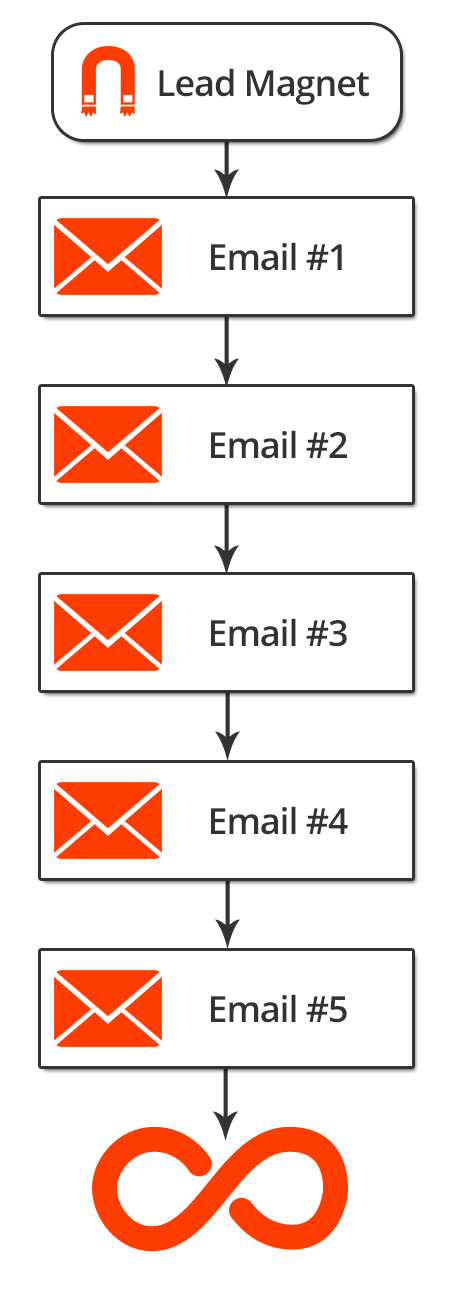
The Purpose Of A “Simple” Sales Funnel
There are a few reasons for this “Simple” Sales Funnel's existence:
- This email series automatically builds and maintains a relationship with your leads and customers while simultaneously converting them to your way of thinking
- This serves as the backbone for more complex email automations we’ll later build on
- Your personal understanding. If you have trouble making emails trigger in a straight line, when we get into more advanced topics you’ll really struggle
How Many “Simple” Sales Funnels Should You Have?
Most of the time, you only need one. The type of content you send in this funnel is interesting to people interested in your type of business or industry.
For example:
- People who are interested digital marketing and sales funnels
- People who are interested in taking care of their personal finances
- People who are interested in maintaining their family's dental health
There are a few instances where you may need 2 or more, for example if you're a lawyer and you have two facets to your business: legal counsel for clients and consulting for other lawyers.
In this case, your customers are tremendously different. People seeking legal counsel have very different interests than other lawyers seeking advice. In this case, you would likely want 2 different “simple” sales funnels.
If you have more than one “Simple” Sales Funnel, you need to segment individuals at the very beginning by asking them “who” they are.
What Type Of Content Should You Send?
Remember, the point of this particular sales funnel is to build and maintain a relationship and convert them to your way of thinking.
To accomplish this, send 3 types of emails:
- Educational – emails that teach people how to do something, about the market, about what’s happening, case studies, etc.
- Entertaining – emails that are “fun” like stories, case studies, testimonials, inside jokes, critiques, events, etc.
- Earning – emails that remind people you offer various products and services.
I’ve aptly named these emails the “3 E Emails”.
Now, this doesn’t mean an email can only be 1 of the Es at a time. Like, you can only send a boring how-to tutorial, or only send a silly cat video. That’s not what I mean. Your how-to tutorial should be entertaining and can even sell your product at the end. That’s like killing 3 birds with one stone!
However, each email should have 1 core focus.
Is the primary aim of the email to educate, entertain, or earn?
- Educational emails tend to build relationships while converting people to your way of thinking
- Entertaining emails tend to build and maintain relationships
- Earn emails tend to ring the cash register
Examples:
Crazy Eye Marketing
- Educational: Send a link to a video showing how to add an opt-in form to a website.
- Entertaining: Share a case study where we split tested several opt-in forms and were able to increase the conversion rate by 57%.
- Earn: Send a 10% off coupon for our optimization course tteaching, step-by-step, how to split test and optimize your opt-in forms.
Financial Advisor
- Educational: Explain the differences and how to get the most out of the various retirement income streams: annuities, social security, pensions, etc.
- Entertaining: Share the story of a successful client that has been with you for the last 10 years, gone through multiple trials and tribulations; however, finally retired and is now traveling the world!
- Earn: Click here to schedule a free consultation with me!
Dentist
- Educational: Share a list of 7 strategies for getting your children to brush their teeth for the appropriate amount of time.
- Entertaining: Send a cute video that shows various animals getting their teeth brushed and enjoying it (my son would love this!).
- Earn: Did you know? We offer free checkups for walk-ins? We do! Visit us today and make sure your mouth is in good shape!
Where Do You Get Content?
Being that you're a coach, consultant, or service-based business and people need to know, like, and trust you – you need to create your own content.
You can't outsource this.
Sure, there are people and businesses that can help you come up with a plan, piece it together, and write the “connecting” material (that's what I do 😉 ); however, the “real” content has to come from you and/or your business.
There's no other way around it.
Of course, this requires a blog or pages setup to present the content.
And remember, content doesn’t necessarily mean blogging. While you still want to display the content on your site to “bring people back”, it could be video, audio (podcasts), images, etc.
For example, if my brother is your target audience, blogging is a terrible idea. He doesn’t read anything and you need to draw him in with video.
HOWEVER, and it’s a pretty big one – Google can’t really “watch” videos. It won’t matter how good your video content is from a search engine perspective. Blogging is still the #1 way to rank in the search results.
The Most Epic Blogging Strategy Of All Time
Here's the best way I've found to approach your content creation strategy:
- Write the most epic post for your ideal customer, as it relates to how they see themselves and how it relates to your business/industry. If that is too esoteric, think of it as, “How does your business help people go from point A (where they are now) to point B (where they want to be/how they see themselves).” (3,000+ words)
- The Ultimate Guide To Marketing Strategy For Coaches, Consultants, & Service-Based Businesses
- The Ultimate Guide To Retiring “Right” So You Can Travel The World
- From Baby To Adult, How To Care For Your Child's Teeth
- Write more in-depth articles for each individual section of your “epic” post. (500-1,000 words)
- 3 Sales Page Formulas That Will Increase Your Conversion Rates
- 5 Things To Do 3 Years Before You Retire
- How To Get Your 2 Year Old To Brush All His Teeth (I need this one!)
- Write case studies, testimonials, reviews, etc. and/or create videos and/or pdf checklists for each of the “more in-depth” articles. (500-1,000 words and/or 3-5 minute video and/or a 1 page checklist)
- Share case studies of the sales page formulas
- Go into even more depth on the 5 things you spoke about in the last article
- 3 Toothbrushes That'll Make Your 2 Year Old Want To Brush Their Teeth!
Of course, you link your products and services as they “fit” the particular articles.
How Often Should You Email?
This answer varies from industry to industry; however, normally – two to four times a week. The first 3-5 emails are sent daily, no matter what, because this is when the lead is “hot”.
During the “Advanced” Sales Funnel portion, there will be more instances where you email daily because the lead will “tell” you they’re “hot” again.
To Do
- Write down 3 EPIC blog post ideas
Lead Magnets
A Lead Magnet can be best thought of as a freebie that motivates individuals to give you their contact information.
Upon receiving the individual's contact information, they're transformed into a lead and begin the journey down your sales funnel.
A few example Lead Magnets formats include coupons, checklists, videos, eBooks, webinars, mini-courses, trial, and other resources.
Beyond the format of the Lead Magnet, there's also the type:
- General
- Specific
General Lead Magnets
A General Lead Magnet is attractive to anyone who visits your website and is usually presented as a form on most pages of your site. The form can be a lightbox, landing mat, sidebar, bar/ribbon, slide-in, etc.
For example, this General Lead Magnet can be found in the side bar of most blog posts on Crazy Eye Marketing:
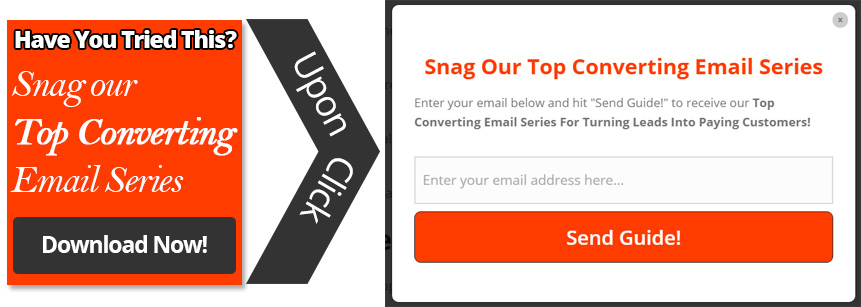
It's “general” in that nearly anyone that visits Crazy Eye Marketing for any reason will be interested in email marketing.
Specific Lead Magnets
A Specific Lead Magnet is attractive to individuals interested in a certain product/service or topic and many times is presented as a Squeeze Page (although, this isn't always the case).
What's a “Squeeze Page”?
A Squeeze Page is a page dedicated to one thing and one thing only – “squeezing” the contact information out of a visitor, turning them into a lead.
Here's an example:
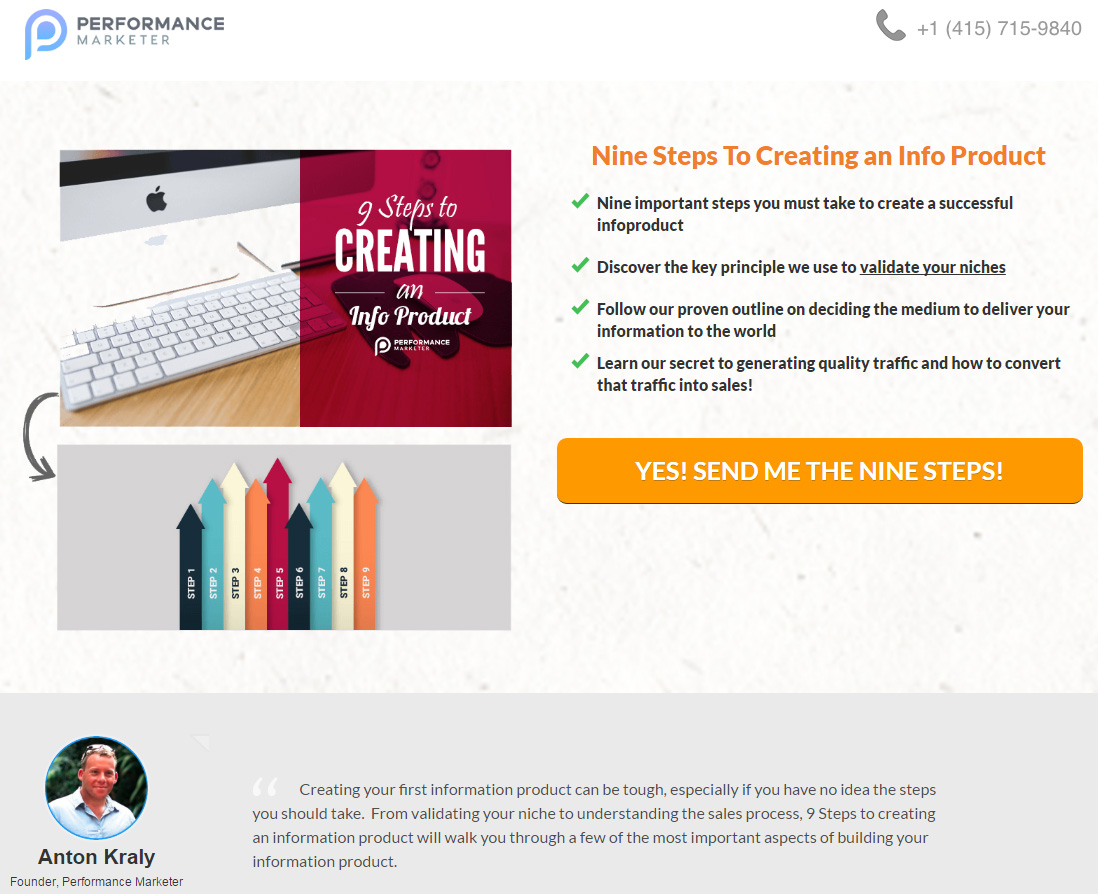
From Performance Marketer
That's an entire page with only two options:
- Click the yellow button to receive the nine steps
- Leave
It's also “specific” in that only people interested in creating information products would be interested in this.
Specific Lead Magnets Should Also…
- Pre-qualify leads (ie. individuals only interested in creating information products)
- Setup the sale of the “next step” ie. the Initial Offer as defined in your Value Ladder
Anton of Performance Marketer does both of these wonderfully … check out the Thank You page after opting in for the “9 Steps”:
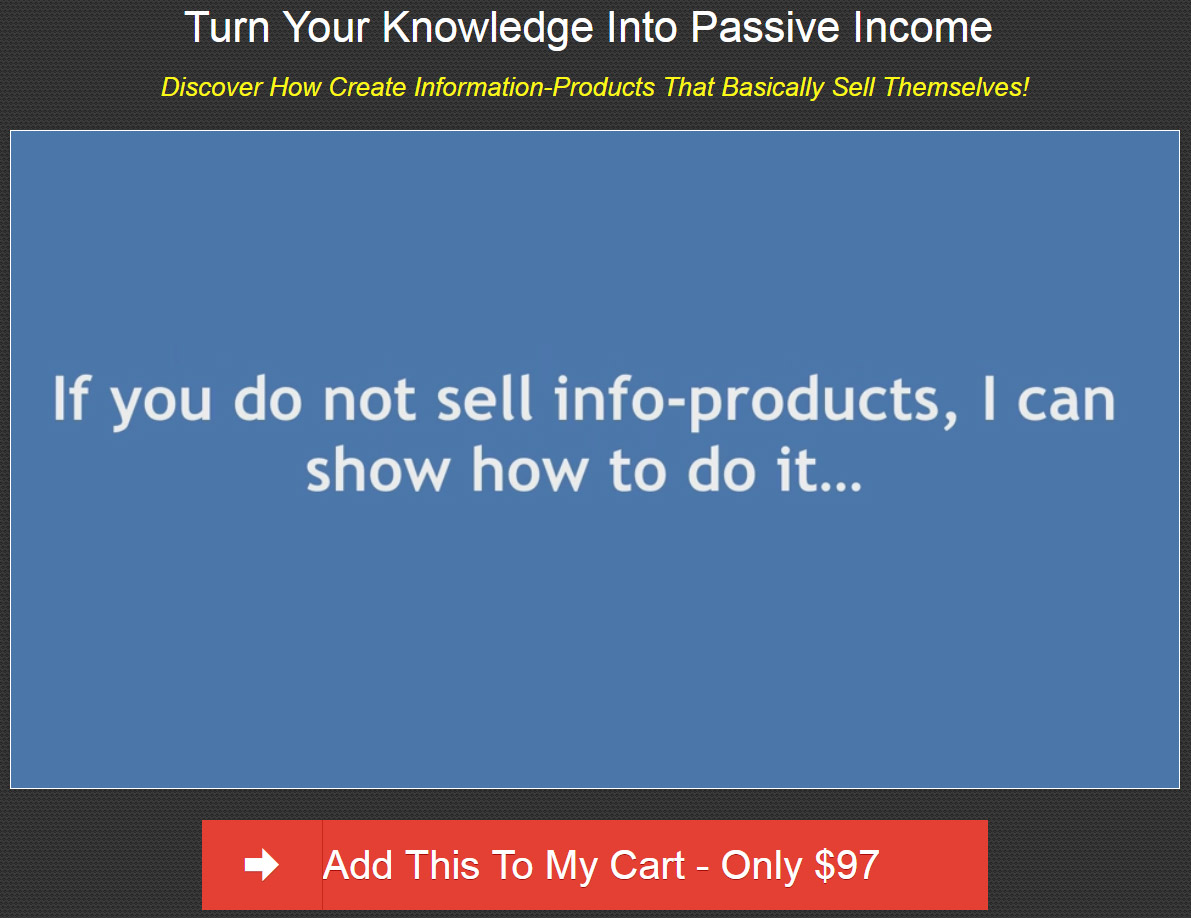
From Performance Marketer
Spectacular! A course on creating info products!
I imagine, if I don't buy his course right away, his autoresponder series will work its magic and sell me on it!
The good news? You can do this type of thing, too!
To Do
Think about what the average visitor to your website would be interested in. Write down 3 ideas for your General Lead Magnet.
Think about your products and services. What could you offer individuals to pre-qualify them AND move them to purchase that particular product or service. Write down 3 ideas for each product/service you offer.
Eventually, you'll actually turn these ideas into Lead Magnets.
The “Advanced” Sales Funnel
The “Advanced” Sales Funnel is driven by interests, hence why I coined it the “Interest Driven Sales Funnel”.
In essence, people join your email list and based on the links they click, pages they view, and lead magnets they request – you send relevant emails in order to try and sell a product.
Here's what an Interest Driven Sales Funnel looks like:
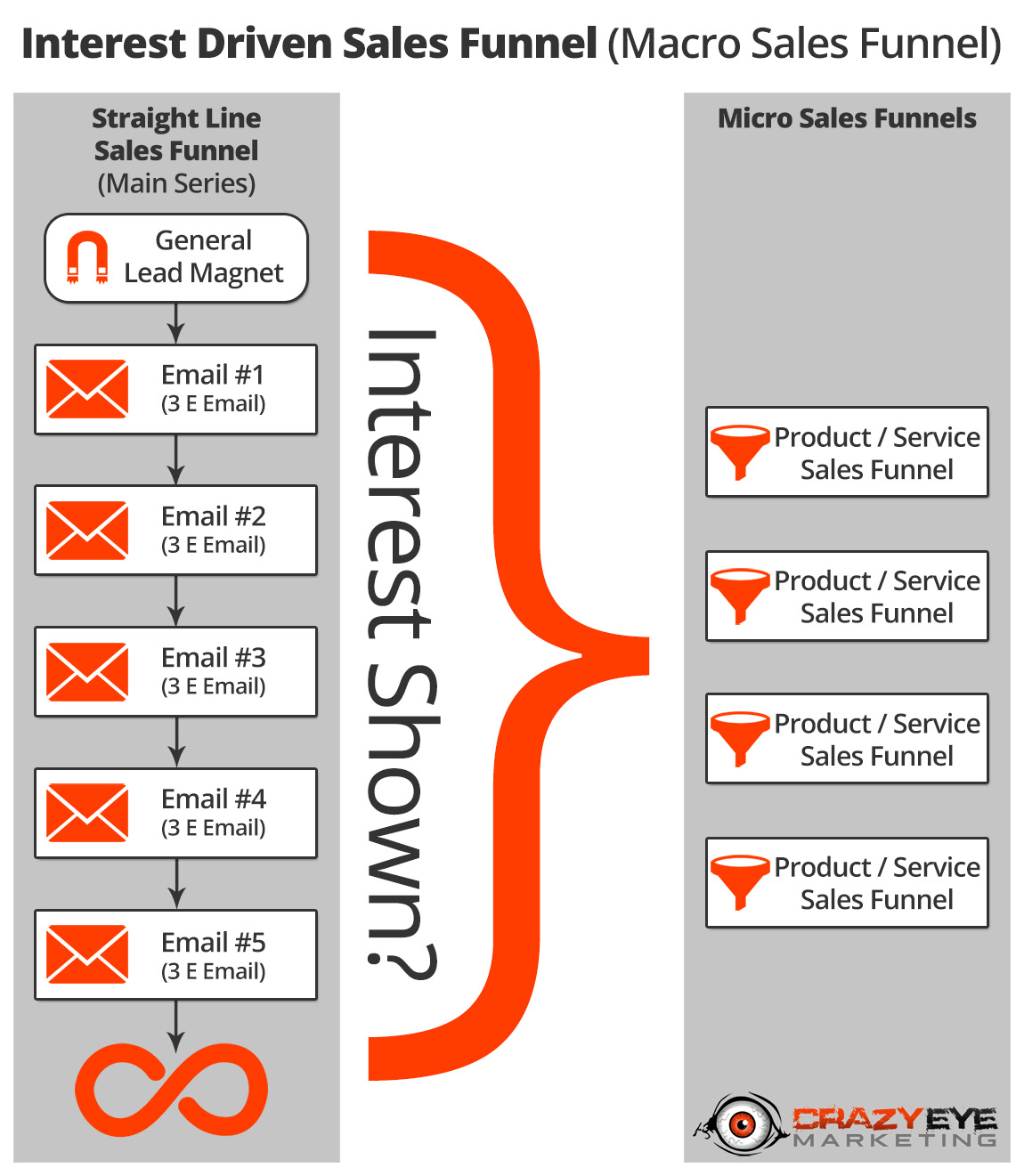
The left hand side shows the “Simple” or “Straight Line” Sales Funnel (also called the “Main Series”).
As previously mentioned, this autoresponder series acts as the backbone for your Interest Driven Sales Funnel. As it sends emails that follow the 3 E strategy (entertain, educate, earn), it automatically pays attention to how people respond to certain emails.
If people respond a certain way (show interest), a “Micro Sales Funnel” (Product / Service Sales Funnel) will automatically trigger. The point of the Micro Sales Funnel is to sell a product or service.
You will likely have lots of Micro Sales Funnels. Ideally, one for each product and/or service you offer.
Here’s an example:
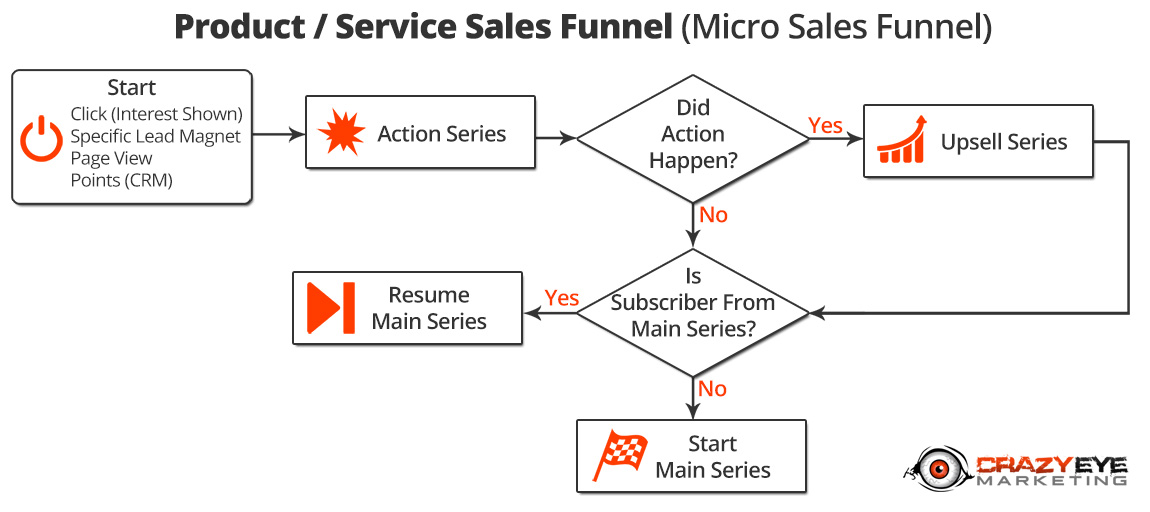
Note: A Micro Sales Funnel may differ from the above example based upon what you’re attempting to sell, your Value Ladder, and your approach.
Quick Explanation
No matter what the Micro Sales Funnel looks like, the start and end will look the same.
The Start
The Start occurs when an individual shows interest in a product/service you offer or a topic you talk about. We can gauge interest by tracking their link clicks, Specific Lead Magnet requests, page views, and via points (if you use a CRM).
The End
The End occurs when an individual has gone through the entire Micro Sales Funnel. If the individual went straight into the Micro Sales Funnel by requesting a Specific Lead Magnet and they have yet to enter the “Main Series” (Straight Line Sales Funnel) – they’ll now enter the Main Series starting at the beginning.
If the individual was in the Main Series, showed interest in a product/service by clicking a link, and entered a Micro Sales Funnel – upon entering the Micro Sales Funnel, their “trip” down the Main Series is paused, and upon exiting the Micro Sales Funnel, they resume their “trip” down the Main Series.
The Rest
Action Series
A few emails that attempt to drive action, ie. a purchase of the product or service the individual has shown interest in.
Did Action Happen?
If the desired action was taken, go to the Upsell Series.
If the desired action was not taken, go to The End.
Upsell Series
An email or two that attempt(s) to either sell more or the next product/service.
Examples
Crazy Eye Marketing
An individual joins the email list by opting in for a Specific Lead Magnet that offers a “Lead Magnet Essentials Checklist”. It's specific, I know the individual is interested in creating Lead Magnets.
We then send 3 emails about Lead Magnets and attempt to sell the corresponding Lead Magnet course.
- Email 1: Case study, show differences between good vs bad Lead Magnets. Include link to course, as the final thought of the email (PS line).
- Email 2: Explain how a good Lead Magnet lowers ad spend, increases authority, etc. While a bad Lead Magnet will cost a lot more to advertise, may attract the wrong people, may hurt your business in the long run. PS line includes a link to the course.
- Email 3: Sell course, maybe offer discount, last time you'll hear me talk about it.
Let’s pretend on Email 2 they purchase the course. We then end that series (we won’t send email 3) and launch into our Upsell Series where we send 2 emails that attempt to sell the Sales Funnel Training Vault.
- Email 1: Explain how Lead Magnets are just 1 piece of a much larger puzzle.
- Email 2: Share a “Before-After-Bridge” story of my life before I fully grasped sales funnels, my life after I understood sales funnels, and show how I got to this point; you can too with The Sales Funnel Training Vault.
After completing the Upsell Series, they enter our Main Series from the beginning where we begin to build and maintain a relationship and gauge interest(s).
Financial Advisor
An individual has been on our email list and in our Main Series for a few weeks when they receive a 3 E email about “how to make sure your money lasts while in retirement”. They click the link contained in the email.
By clicking the link, we know they’re interested in “how to make sure your money lasts while in retirement”. We pause the Main Series and trigger 3 emails (Action Series) about that topic, while promoting our products/services.
Goal of these emails: Get individual to schedule a call
- Email 1: 5 Strategies For Controlling Your Spending, So You'll Never Run Out Of Money
- Email 2: Should You Handle Your Own Money In Retirement?
- Email 3: The True Story Of Sarah And John. Tell a story of a couple that retired and traveled the world without worry because their finances were handled by a professional.
No Upsell Series here. Due to the fact financial investment is a very personal topic and event, we only need to get them to give us their money once, becoming their “financial guy/gal”.
After the Action Series, the individual resumes the Main Series exactly where they left off.
Dentist
An individual registers for their 6 month checkup. On the checkout page, we ask if they also want to get their teeth whitened at a discounted rate. If they say no, we ask again on the Thank You Page (1-click upsell). If they say no again, we send 1 email – “Last Chance: Teeth Whitening” where we offer them one last chance to get the teeth whitened at the discounted rate.
More On Interest Driven Sales Funnels
Providing tailored content to your audience increases conversions. You have to provide content people are interested in or they leave without buying. An Interest Driven Sales Funnel automatically adjusts to peoples' interests based on their actions and sends content they actually want.
It's an incredibly powerful strategy that any business can benefit from.
Click here to learn more and checkout more Product/Service Sales Funnels!
To Do
- Pick a product or service that has a Specific Lead Magnet or piece of content (blog post, video, etc.) tied to it. Write 3-5 Action Series ideas (like I did above) on how to convert those leads (individuals who showed interest in that topic or product/service) into customers.
- Write down 1-3 Upsell Series ideas if they purchase that product/service from you (if applicable).
Note: Many of these emails will likely link to blog posts and other content you’ve created, fitting nicely within the Epic Blogging Strategy I outlined above.
Traffic
There are as many ways to drive traffic as there are people on this planet, so it's impossible to discuss them all in detail in one blog post; however, I'll share several strategies that'll frame how you should look at traffic generation.
Before I get to the rules, I want you to know that I break advertising into two categories that incorporate both online and offline methods:
- “Free” Advertising: A form of advertising that costs time. Examples include SEO, Social Media, Podcasts, and Cold Calling.
- Paid Advertising: A form of advertising that costs money. Examples include Facebook Ads, Google Adwords, Newspaper and Radio Ads.
#1 Advertise Where Your Audience Hangs Out
Makes sense, right?
Make sure you're abiding by this rule, otherwise all other actions are futile.
#2 Have Multiple Streams
You never, ever, want to be dependent upon one single source of traffic. Platforms change, algorithms change, new platforms emerge, people move – things change.
You never want to have your entire business dry up overnight, trust me. I was solely dependent on Google, one little algorithm change and my business had to shut its doors.
The ideal situation is to have a mixture of “free” and paid traffic coming to your business.
#3 Patience
Whether you're dealing with “free” or paid traffic, it's going to take time and/or money to get platforms figured out.
In 2016, SEO typically takes between 9-12 months before it starts to show.
Social media, unless you gain some virality, typically takes a long time to grow a following. Even if you “go viral” you still have to capture and maintain that relationship (ideally by adding them to your sales funnel) – or you're just a flash in the pan.
Paid traffic comes with a learning curve. Most of your ad campaigns will fail at first. It will take time and money to figure out what does and doesn't work with regard to your particular market and business.
Basically, you can't spend $10 and expect magical results. Expect to spend over $1,000 before you start figuring out a particular paid traffic source.
#4 Measure Everything
You have to measure your results, otherwise you'll make bad decisions.
Google Analytics is a great, free tool that can help with tracking.
Most paid advertising platforms have the advantage of built in tracking.
You have to track your numbers.
Think about Shark Tank for a second. If anyone walks into “The Tank” and doesn't know their numbers … they're eaten alive!
Don't get eaten alive!
Know your numbers.
To Do
Consider your audience. Think about where they hangout, whether online or offline. Write down a mixture of 5 “free” and paid traffic sources to reach your audience in these locations.
Optimization
Unfortunately, you cannot optimize something you don’t have – so, you need to implement the marketing strategy you drafted with the help of this post.
However, when you begin optimizing your sales funnel, there are ways to think about it on macro and micro levels.
Macro Level
Your entire sales system is an integrated system.
Who your customers are, where they hangout, how you present your business, how you deliver your products, your product listings, your pages, your emails, your ads … it’s all integrated and how well one part performs affects the other parts.
For example, if you’re advertising to the wrong people, it doesn’t matter how good everything else is, your entire system will fail.
If you’re unable to match your products to your customers' needs, your entire system will fail.
The Golden Rule
Start at the beginning.
If you’re having trouble with your sales system, start at the beginning – with your customers. If you’re absolutely positive you’re attracting the correct customers, move on to your business – how you portray yourself, what you sell and how you sell it (Value Ladder).
Does everything make sense? Is the “flow” of the Value Ladder natural? Is your business’s persona coming across as sincere or insincere?
How are your products listed on your sales pages? Do you have high quality photos? Good copy that’s attractive to your ideal customer? Is the checkout process easy?
Work your way through the entire system, piece by piece.
If the early stuff isn’t right, it won’t matter how good the later stuff is, no one will ever get to it.
Micro Level
Beyond optimizing at the Macro Level, you have the Micro Level – and, to be honest, this is what most people focus on already.
These are things like email subject lines, page titles, calls-to-actions (CTA), ads, etc.
The good part is, a few % increases here and there can increase the performance of the entire system very quickly.
For example:
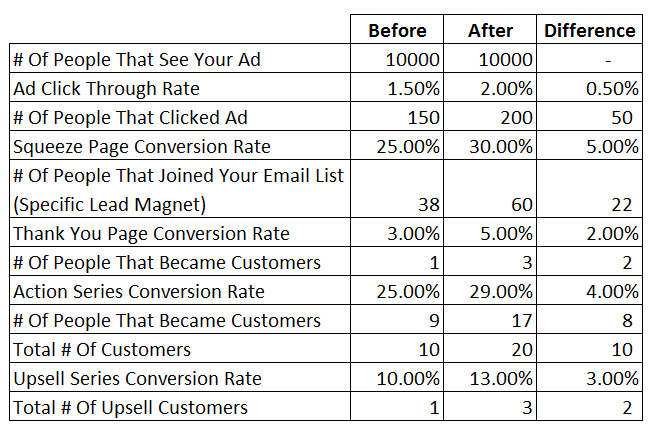
A few minor tweaks (all 5% increases or less) to the ad, squeeze page, thank you page, action series, and upsell series resulted in 10 more customers than before and 2 additional upsells.
Imagine if only the ad’s CTR increased … what would happen …
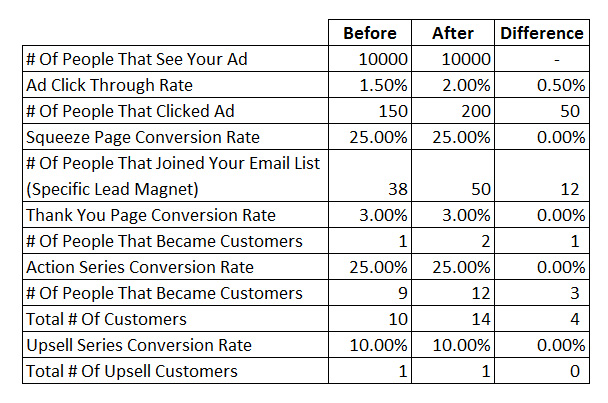
We’d still add 4 more customers!
It’s amazing what even a half-percent change can do!
To Do
Implement.
How To Implement
This post should have your Coaching, Consulting, or Service-Based Business on a path for success; however, there’s still a lot of work and technical understanding that needs to happen.
There’s still …
- Email marketing automation configuration
- Landing page and opt-in form integration
- Advertising campaign launches and optimization
- Tracking tools and pixels to implement
- Various other areas that’ll need tweaking
Of course, you can piecemeal all this together from various sources, or you can save a bunch of time, effort, and energy by joining The Vault!
The Vault includes all the training, resources, and support you need to implement everything you planned above!
